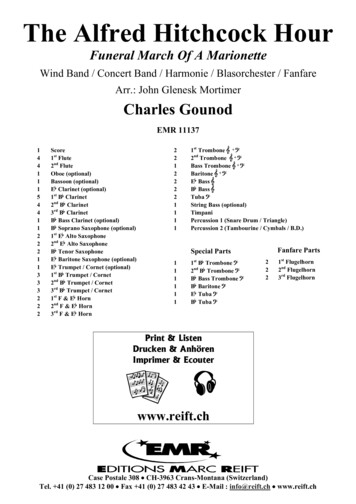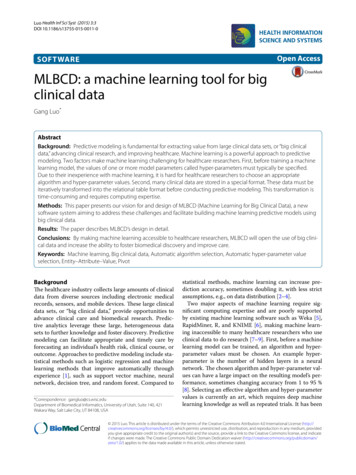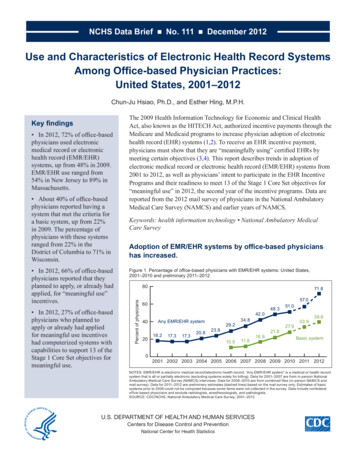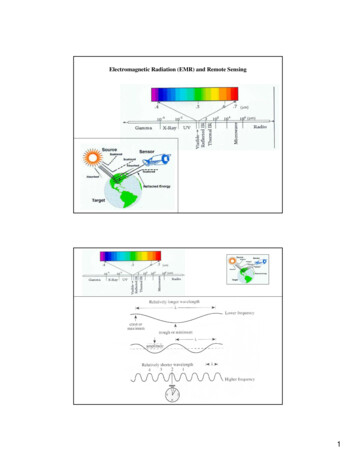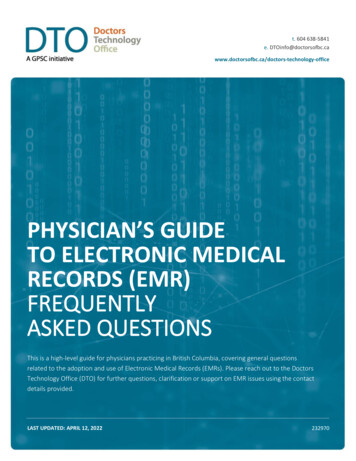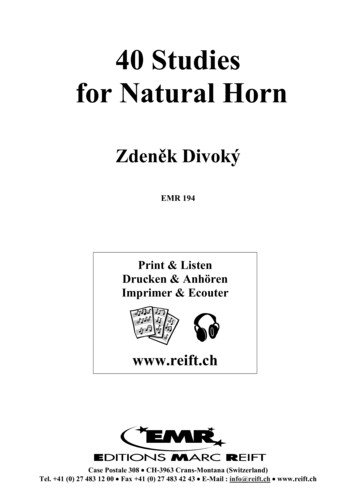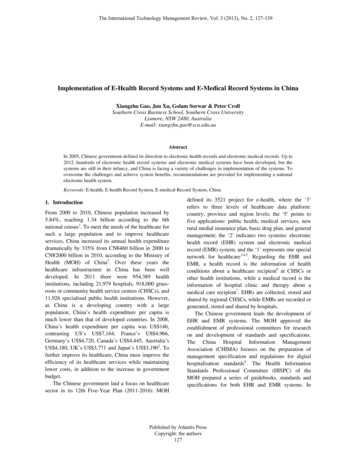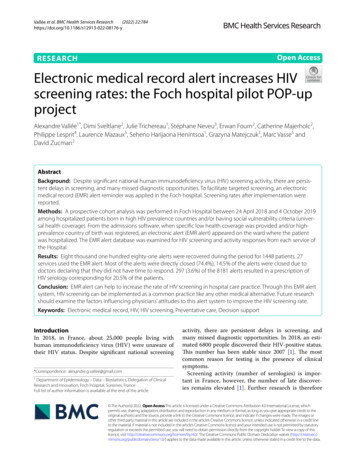
Transcription
COMPENDIUM OF EVIDENCE-BASED INTERVENTIONS AND BEST PRACTICES FOR HIV PREVENTIONELECTRONIC MEDICAL RECORD (EMR)REMINDER FOR HIV SCREENINGEvidence-Informed Structural InterventionINTERVENTION DESCRIPTIONGoals of Intervention Increase HIV testingTarget Population Clinic patientsBrief DescriptionElectronic Medical Record (EMR) Reminder for HIV Screening facilitates universal HIV testingby adding a routine passive EMR reminder for all patients aged 13–65 years at an academichospital-based primary care practice. The provider reminder appears on the home page ofeach patient’s EMR in small red text that reads “HIV antibody” alongside other clinicalreminders. If a test is performed, the reminder automatically disappears. The practitionercan also manually enter testing information if the patent declines testing or receives a testat a different institution.Theoretical BasisNone reportedIntervention Duration OngoingIntervention Setting Hospital-based primary care practiceDeliverer Healthcare staffDelivery Methods Provider remindersStructural Components Accesso Increased access to HIV testing Capacity building -- Technologyo Routine passive reminder for HIV screening added to EMRSI Chapter – Electronic Medial Record (EMR) Reminder for HIV ScreeningLast updated December 31, 2019
COMPENDIUM OF EVIDENCE-BASED INTERVENTIONS AND BEST PRACTICES FOR HIV PREVENTIONINTERVENTION PACKAGE INFORMATIONAn intervention package is not available at this time. Please contact Colleen Kershaw,Section of Infectious Diseases and International Health, Dartmouth-Hitchcock MedicalCenter, One Medical Center Drive, Suite 5C, Lebanon, New Hampshire 03766.Email: colleen.m.kershaw@hitchcock.org for details on intervention materials.EVALUATION STUDY AND RESULTSStudy Location InformationThe original evaluation study was conducted in Boston, MA between January 2012 and October 2015.Key Intervention Effects Increased HIV testingRecruitment Settings Hospital-based primary care practiceEligibility CriteriaPatients were included in the analysis if they were between the ages of 18–65 years, a patient in the adultinternal medicine practice, had at least one visit in the practice during the 2.5-year study period, and had notbeen tested previously for HIV.Study SampleParticipants in the post-implementation cohort (i.e., individuals who had a care visit in the practice after EMRreminder implementation, n 20,640) had the following characteristics: 62% white, 17% black or African American, 12% other; 7% Asian 58% female, 42% male 8% 25 years old, 22% 26-35 years old, 19% 36-45 years old, 51% 46-65 years oldAssignment Method Not applicableComparisonThis study uses a serial, cross-sectional clinic design. Participants in the post-EMR implementation period (i.e.,participants who had a care visit between October 30, 2013 and October 30, 2015) were compared toparticipants in the pre-implementation cohort (i.e., participants who had a care visit between January 1, 2012and October 29, 2013). A patient could appear in both cohorts (pre and post) if he or she had at least one visitin the pre-implementation period, did not have HIV testing in the pre-implementation period, and had a visitin the post-implementation period. Because of this possibility, the observations used in the analysis were notindependent when comparing the cohort samples (pre vs. post).SI Chapter – Electronic Medial Record (EMR) Reminder for HIV ScreeningLast updated December 31, 2019
COMPENDIUM OF EVIDENCE-BASED INTERVENTIONS AND BEST PRACTICES FOR HIV PREVENTIONRelevant Outcomes Measured HIV testing was measured as the proportion of patients receiving an HIV test before and after EMRimplementation HIV incidence was measured as the proportion of patients with a new HIV diagnosis before and after EMRimplementationParticipant RetentionBecause participant retention is not a criterion for the Structural Interventions (SI) chapter, the PreventionResearch Synthesis project does not evaluate that information.Significant Findings on Relevant Outcomes HIV incidence was significantly higher in the post-implementation period compared to the preimplementation period (0.7% vs. 0.3%, p 0.0001). The percentage of clients receiving HIV testing was significantly higher among post-implementationparticipants than pre-implementation participants (30.7% vs. 15.3%, respectively, RR 2.02, 95% CI 1.95–2.09, p 0.0001). Additionally, HIV testing was also significantly higher among post-implementationparticipants than pre-implementation participants, respectively, for the following subgroups:o Age: Participants age 25 (34.3% vs. 22.5%, RR 1.52, 95% CI 1.38–1.69, p 0.0001) Participants ages 26-35 (36.9% vs. 23.1%, RR 1.61, 95% CI 1.53–1.71, p 0.0001) Participants ages 36-45 (31.0% vs. 15.8%, RR 1.98, 95% CI 1.83–2.13, p 0.0001) Participants ages 46-65 (27.2% vs. 9.7%, RR 2.81, 95% CI 2.65–2.99, p 0.0001)o Gender: Female participants (30.5% vs. 14.0%, RR 2.19, 95% CI 2.10–2.30, p 0.0001). Male participants (30.8% vs. 17.3%, RR 1.82, 95% CI 1.73–1.91, p 0.0001)o Race: White participants (27.1% vs. 13.9%, RR 1.97, 95% CI 1.88–2.07, p 0.0001). Black participants (41.0% vs. 21.5%, RR 1.93, 95% CI 1.81–2.06, p 0.0001). Asian participants (30.3% vs. 14.5%, RR 2.11, 95% CI 1.85–2.40, p 0.0001). Participants of other races (33.4% vs. 14.6%, RR 2.31, 95% CI 2.12–2.51, p 0.0001).o Language: English speaking participants (30.4% vs. 15.3%, RR 2.01, 95% CI 1.94–2.08, p 0.0001). Non-English-speaking participants (37.5% vs. 17.2%, RR 2.20, 95% CI 1.89–2.56, p 0.0001).o Household Incomes: Participants living in zip codes with household incomes lower than the median income of 67,338(34.9% vs. 19.1%, RR 2.28, 95% CI 2.16–2.40, p 0.0001). Participants living in zip codes with household incomes higher than the median income of 67,338(26.9% vs. 11.9%, RR 1.85, 95% CI 1.77–1.93, p 0.0001). In the sensitivity analysis, HIV testing was significantly higher among new patients in the postimplementation period compared to those in the pre-implementation period (32.9% vs. 22.5%, RR 1.46, p 0.0001).Strengths None identifiedSI Chapter – Electronic Medial Record (EMR) Reminder for HIV ScreeningLast updated December 31, 2019
COMPENDIUM OF EVIDENCE-BASED INTERVENTIONS AND BEST PRACTICES FOR HIV PREVENTIONConsiderationsAdditional significant positive findings on non-relevant outcomes None reportedNon-significant findings on relevant outcomes None reportedNegative findings None reportedOther related findings Among attending physicians, the percentage of patients receiving HIV testing was significantly higher in thepost-implementation period compared to the pre-implementation period (29.5% vs 13.9%, RR 2.14, 95%CI 2.05–2.23, p 0.0001). Among resident physicians, the percentage of patients receiving HIV testing was significantly higher in thepost-implementation period compared to the pre-implementation period (36.9% vs 21.7%, RR 1.72, 95% CI 1.60–1.84, p 0.0001). During the time period between June 26, 2012 (the date of change in Massachusetts law requiring writtenconsent for HIV testing), up to the date of the reminder implementation, the percentage of HIV testingamong patients in the practice was 16.5% (4094/24842). In the study period after the reminder, HIV testingproportion increased to 31.3% (6505/20817), p-value 0.0001.Implementation-related findings None reportedAdverse events None reportedFundingNo funding sources were reported.SI Chapter – Electronic Medial Record (EMR) Reminder for HIV ScreeningLast updated December 31, 2019
COMPENDIUM OF EVIDENCE-BASED INTERVENTIONS AND BEST PRACTICES FOR HIV PREVENTIONREFERENCES AND CONTACT INFORMATIONKershaw, C., Taylor, J. L., Horowitz, G., Brockmeyer, D., Libman, H., Kriegel, G., & Ngo, L. (2018). Use of anelectronic medical record reminder improves HIV screening. BMC Health Services Research, 18(1):14.Researcher: Colleen Kershaw, MDSection of Infectious Diseases and International HealthDartmouth-Hitchcock Medical CenterOne Medical Center Dr., Suite 5CLebanon, NH 03753Email: colleen.m.kershaw@hitchcock.orgSI Chapter – Electronic Medial Record (EMR) Reminder for HIV ScreeningLast updated December 31, 2019
Electronic Medical Record (EMR) Reminder for HIV Screening. . SI Chapter - Electronic Medial Record (EMR) Reminder for HIV Screening . Last updated December 31, 2019 . INTERVENTION PACKAGE INFORMATION An intervention package is not available at this time. . (30.7% vs. 15.3%, respectively, RR 2.02, 95% CI 1.95- .
